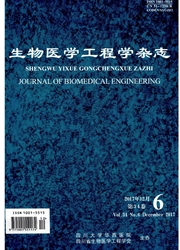

 中文摘要:
中文摘要:
尖端扭转型(Torsades de Pointes.TdP)室性心动过速是一种严重的心律失常。心肌缺血是诱发TdP的主要原因之一。我们借助计算机仿真技术,利用Noble98心室肌动作电位动力学模型,在一维匀质心肌组织上,定量研究缺血易导致心律失常的机制。首先通过独立减小Na^+电导、提高细胞外K^+浓度或减小细胞间缝隙偶联电导构建了缺血时组织兴奋性降低、细胞外K^+蓄积或偶联减弱的模型,分别研究了各种情况对生理特性的影响。之后将三种参数组合,建立不同程度缺血模型并对其进行了研究。仿真结果显示随缺血程度增大,传导速度明显减慢、动作电位时程明显缩短、易损窗宽度显著增大,极易导致单向传导阻滞,形成折返性心律失常。
 英文摘要:
英文摘要:
Torsades de Pointes is a kind of severe ventricular arrhythmia. Myocardial ischaemia is one of the major causes leading to TdP. In this paper the mechanisms of the TdP were quantitatively studied under the condition of ischaemia based on the Noble98 dynamic model of the ventricular action potential. The study was conducted on one-dimensional homogeneous myocardium with the method of computer simulation. The models were firstly developed to simulate the lower excitability, extracellular accumulation of the K^+ concentration or the decreased gap junctions in ischaemic myocardium. By separately reducing the Na^+ conductance, increasing the extracellular K^+ concentration or decreasing the conductance of the gap junctions enabled us to study the effect of each change in isolation. Then different degrees of ischaemic models were established to study their physiological features. The study showed that the conduction velocity became slower with the ischaemia aggravation, the action potential duration became shorter and the width of the vulnerable window obviously became larger than the normal conditions. The results illustrated that ischaemia was easily leading to unidirectional condustion block and resulted in re-entry and arrhythmias.
 同期刊论文项目
同期刊论文项目
 同项目期刊论文
同项目期刊论文
 期刊信息
期刊信息
